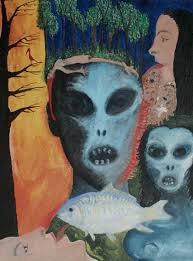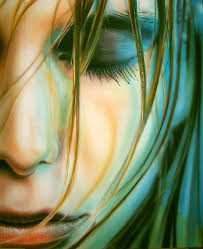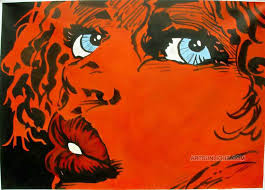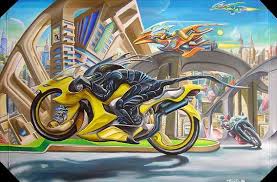Source:- Google.com.pk
Acrylic Paintings Biography
Milton Resnick (January 7, 1917 - March 12, 2004) was a major abstract expressionist painter and teacher known for his mystical, abstract and figurative paintings. Born in Bratslav, Russia, he emigrated to the United States in 1922.
Contents [hide]
1 Biography
2 Public collections
3 Representation
4 See also
5 References
6 Sources
7 Books
8 External links
[edit]Biography
Milton Resnick was one of the last survivors of the first generation of the New York Abstract Expressionists. Born in Russia, Resnick and his family left and arrived in New York City in 1922 at age five. He settled in Brooklyn with his family and attended public school where a teacher renamed him from his birth name of Rachmiel and nickname of Milya to Milton. At age 14, he enrolled in the commercial art program at the Pratt Institute Evening School of Art in Brooklyn, but a teacher there suggested he switch to fine arts, so the next year he enrolled in the American Artists' School in New York City. Ad Reinhardt, future Abstract Expressionist, was a classmate, and they shared a budding interest in abstraction.
However, Resnick's father forbid any expression from his son of wanting to be an artist and faced with this disapproval of his commitment to painting, Resnick moved out in 1934 when he was 17. He supported himself as an elevator boy and continued at the American Artists' School, where he was given a small studio room and each day provided with materials left behind by students attending night classes.
During the Great Depression, Resnick was in the Easel and Mural Division of the WPA of the Works Progress Administration. By 1938, he had his own studio on West 21st Street, and there was nearby Willem de Kooning with whom he formed a close friendship in the 1940s. However, Resnick's art career was interrupted by World War II, and he served five years in the Army, stationed in Iceland and Europe. After the war he lived for three years in Paris, where among others, he associated with modernist sculptors Alberto Giacometti and Constantin Brâncuşi. He endured near-starvation during this period only to have the one show of his work created in Paris canceled by an unsavory dealer.
In 1948, Milton Resnick returned to New York, and used his G.I. benefits to enroll in abstract expressionist painter Hans Hofmann's school. He also took a studio on East 8th Street, near Jackson Pollock, de Kooning, and Franz Kline, and in September through de Kooning met artist Pat Passlof,[2] whom he married in 1961. Passlof was also an accomplished abstract expressionist painter and remained married to Resnick until his death in 2004. Passlof died of cancer in November 2011.
In the late forties he debated painting with his friends and colleagues Willem de Kooning, Lee Krasner and Jackson Pollock, sometimes at The Club,[3][4] a regular meeting of modern artists working in and around Tenth Street in New York.[5] Like them Resnick was striving for an overall quality for his pictures, a way to unite foreground and background, in order to achieve a resolution of opposites, a metaphor for all dialectics. While the others moved toward throwing or dragging quantities of paint across the face of the canvas, Resnick retained a particularly personal and impassioned confrontation with brush painting. Sometimes his work was referred to as Abstract Impressionism because of his all over style. Coming into prominence just as Pop Art moved into the limelight, his great accomplishments weren't recognized to the extent some thought they merited, as a painterly integration of Western metaphysics and Eastern philosophy. In his mature years, he worked in a converted synagogue on Eldridge Street in the Lower East Side, attended by devoted students, admirers, and his wife and lifelong companion, the painter Pat Passlof (1928–2011).[2]
During the 1950s and 1960s, Resnick earned respect for his Abstract Expressionist paintings and also was unique for being one of the few New York artists to have a large working space for large-scale canvases. In 1976, he purchased the space that served him to the end of his active career, an abandoned synagogue on Eldridge Street on New York's lower east side. It was near his wife's studio, which was another abandoned synagogue and purchased by the couple in 1963.
[edit]Public collections
The Akron Art Museum (Akron, OH), the Arizona State University Art Museum (Tempe, AZ), the Chrysler Museum of Art (Norfolk, VA), the Jack S Blanton Museum of Art (University of Texas, Austin, TX), the Honolulu Museum of Art, the Montana Historical Society (Helena, MT), the Museum of New Mexico (Santa Fe, NM), the National Gallery of Art (Washington, DC), the Neuberger Museum of Art (Purchase, NY), the Oakland Museum of California (Oakland, CA), the Phoenix Art Museum, the Roswell Museum and Art Center (Roswell, NM), the San Francisco Museum of Modern Art, the Smithsonian American Art Museum (Washington, DC), the Nelson-Atkins Museum of Art (Kansas City), the University of Arizona Museum of Art (Tucson, AZ), and the Whitney Museum of American Art (New York City) are among the public collections holding work by Milton Resnick.








Acrylic Paintings Biography
Milton Resnick (January 7, 1917 - March 12, 2004) was a major abstract expressionist painter and teacher known for his mystical, abstract and figurative paintings. Born in Bratslav, Russia, he emigrated to the United States in 1922.
Contents [hide]
1 Biography
2 Public collections
3 Representation
4 See also
5 References
6 Sources
7 Books
8 External links
[edit]Biography
Milton Resnick was one of the last survivors of the first generation of the New York Abstract Expressionists. Born in Russia, Resnick and his family left and arrived in New York City in 1922 at age five. He settled in Brooklyn with his family and attended public school where a teacher renamed him from his birth name of Rachmiel and nickname of Milya to Milton. At age 14, he enrolled in the commercial art program at the Pratt Institute Evening School of Art in Brooklyn, but a teacher there suggested he switch to fine arts, so the next year he enrolled in the American Artists' School in New York City. Ad Reinhardt, future Abstract Expressionist, was a classmate, and they shared a budding interest in abstraction.
However, Resnick's father forbid any expression from his son of wanting to be an artist and faced with this disapproval of his commitment to painting, Resnick moved out in 1934 when he was 17. He supported himself as an elevator boy and continued at the American Artists' School, where he was given a small studio room and each day provided with materials left behind by students attending night classes.
During the Great Depression, Resnick was in the Easel and Mural Division of the WPA of the Works Progress Administration. By 1938, he had his own studio on West 21st Street, and there was nearby Willem de Kooning with whom he formed a close friendship in the 1940s. However, Resnick's art career was interrupted by World War II, and he served five years in the Army, stationed in Iceland and Europe. After the war he lived for three years in Paris, where among others, he associated with modernist sculptors Alberto Giacometti and Constantin Brâncuşi. He endured near-starvation during this period only to have the one show of his work created in Paris canceled by an unsavory dealer.
In 1948, Milton Resnick returned to New York, and used his G.I. benefits to enroll in abstract expressionist painter Hans Hofmann's school. He also took a studio on East 8th Street, near Jackson Pollock, de Kooning, and Franz Kline, and in September through de Kooning met artist Pat Passlof,[2] whom he married in 1961. Passlof was also an accomplished abstract expressionist painter and remained married to Resnick until his death in 2004. Passlof died of cancer in November 2011.
In the late forties he debated painting with his friends and colleagues Willem de Kooning, Lee Krasner and Jackson Pollock, sometimes at The Club,[3][4] a regular meeting of modern artists working in and around Tenth Street in New York.[5] Like them Resnick was striving for an overall quality for his pictures, a way to unite foreground and background, in order to achieve a resolution of opposites, a metaphor for all dialectics. While the others moved toward throwing or dragging quantities of paint across the face of the canvas, Resnick retained a particularly personal and impassioned confrontation with brush painting. Sometimes his work was referred to as Abstract Impressionism because of his all over style. Coming into prominence just as Pop Art moved into the limelight, his great accomplishments weren't recognized to the extent some thought they merited, as a painterly integration of Western metaphysics and Eastern philosophy. In his mature years, he worked in a converted synagogue on Eldridge Street in the Lower East Side, attended by devoted students, admirers, and his wife and lifelong companion, the painter Pat Passlof (1928–2011).[2]
During the 1950s and 1960s, Resnick earned respect for his Abstract Expressionist paintings and also was unique for being one of the few New York artists to have a large working space for large-scale canvases. In 1976, he purchased the space that served him to the end of his active career, an abandoned synagogue on Eldridge Street on New York's lower east side. It was near his wife's studio, which was another abandoned synagogue and purchased by the couple in 1963.
[edit]Public collections
The Akron Art Museum (Akron, OH), the Arizona State University Art Museum (Tempe, AZ), the Chrysler Museum of Art (Norfolk, VA), the Jack S Blanton Museum of Art (University of Texas, Austin, TX), the Honolulu Museum of Art, the Montana Historical Society (Helena, MT), the Museum of New Mexico (Santa Fe, NM), the National Gallery of Art (Washington, DC), the Neuberger Museum of Art (Purchase, NY), the Oakland Museum of California (Oakland, CA), the Phoenix Art Museum, the Roswell Museum and Art Center (Roswell, NM), the San Francisco Museum of Modern Art, the Smithsonian American Art Museum (Washington, DC), the Nelson-Atkins Museum of Art (Kansas City), the University of Arizona Museum of Art (Tucson, AZ), and the Whitney Museum of American Art (New York City) are among the public collections holding work by Milton Resnick.
Acrylic Paintings
Acrylic Paintings
Acrylic Paintings
Acrylic Paintings
Acrylic Paintings
Acrylic Paintings
Acrylic Paintings
Acrylic Paintings
Acrylic Paintings
Acrylic Painting Lessons Preview - Simple Clouds By Tim Gagnon
How To Paint With Acrylic Paint
No comments:
Post a Comment